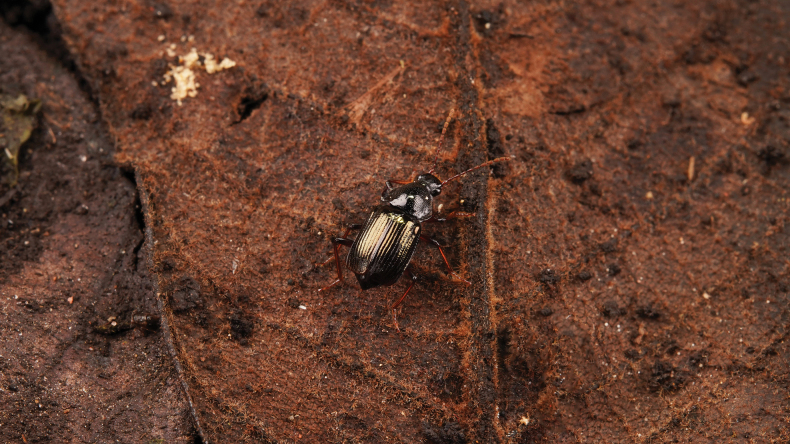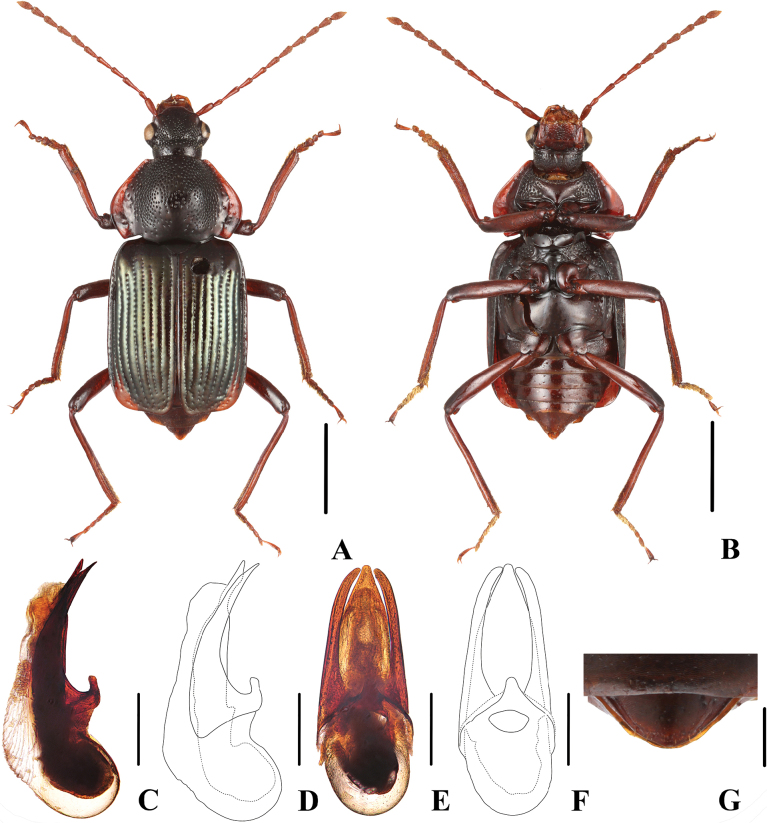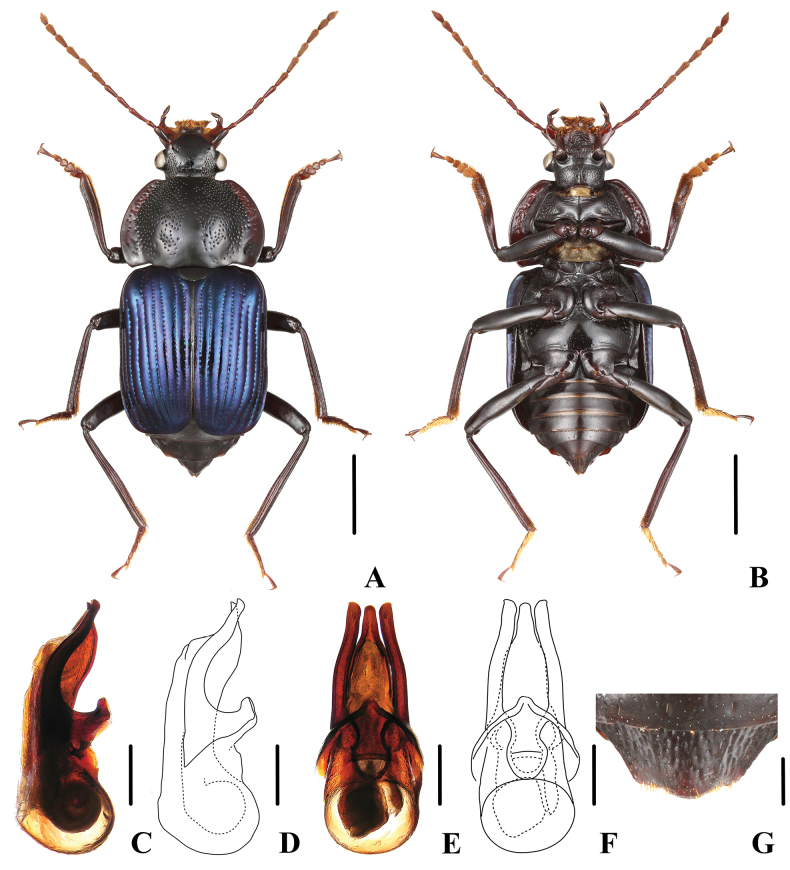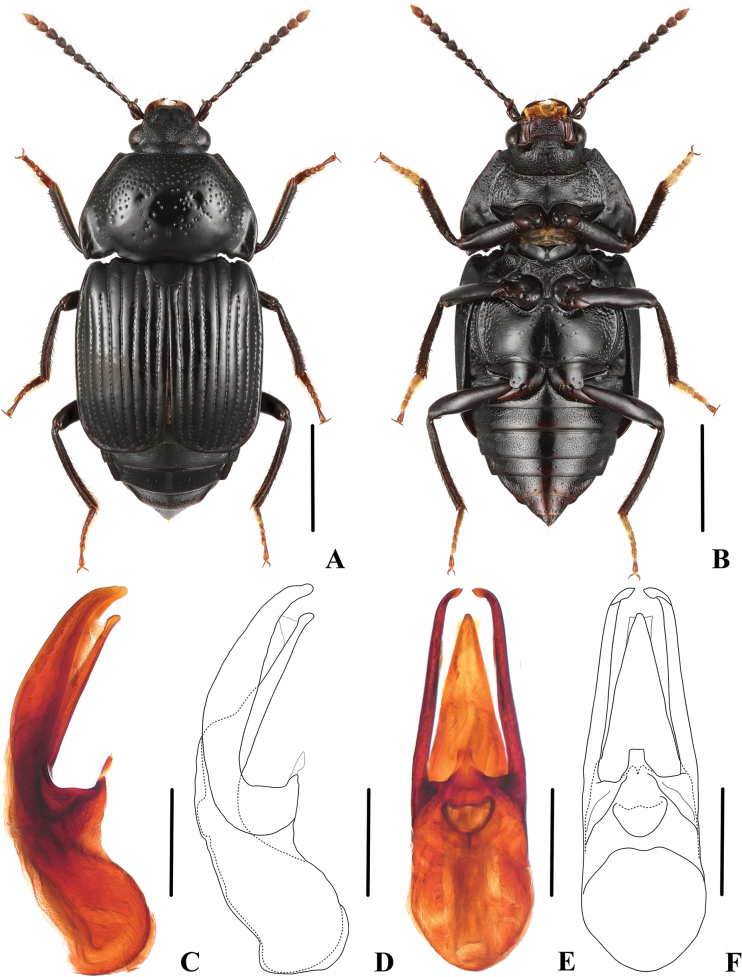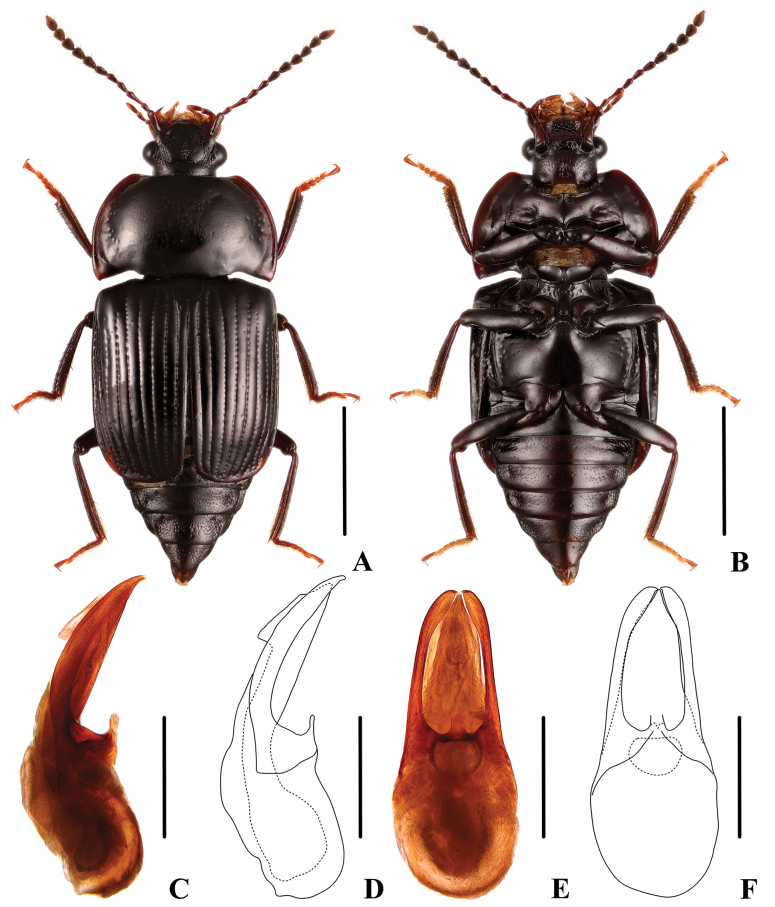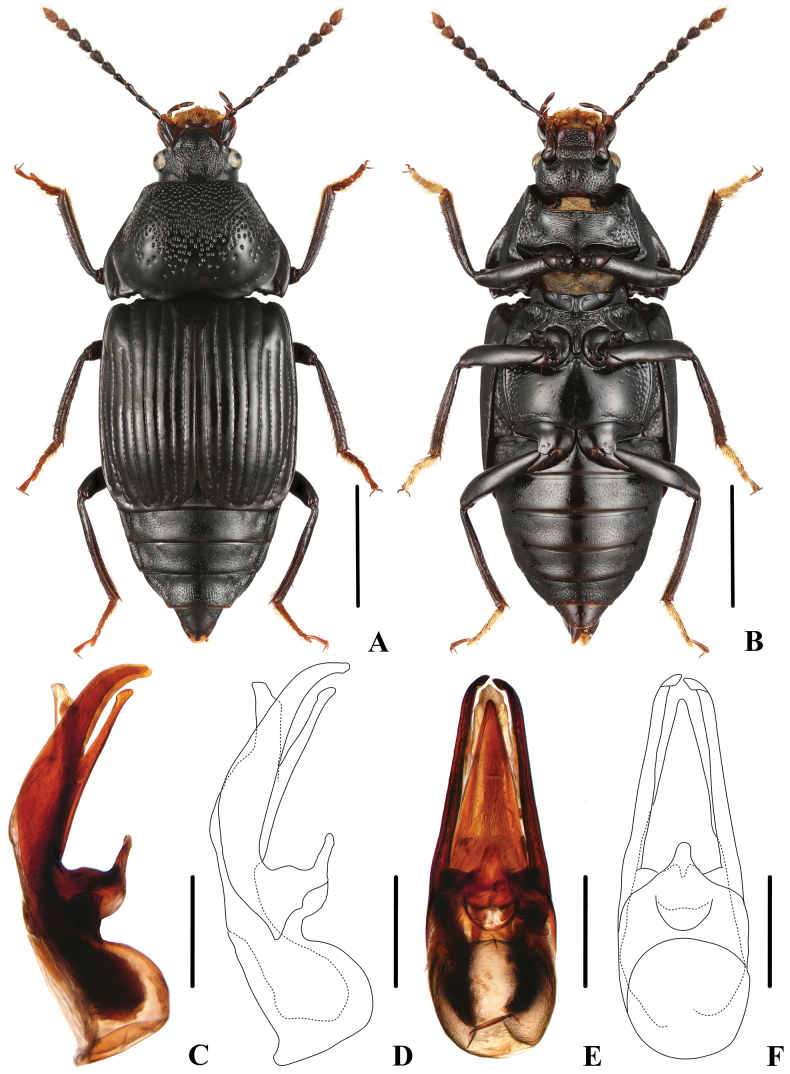Abstract
Five species of Apatetica Westwood, 1848 from China are recorded and illustrated: Apateticaangusticollissp. nov. from Sichuan, A.confusa Assing, 2018 from Yunnan, A.intermedia Cameron, 1930 from Sichuan, A.laevicollis Fauvel, 1904 from Guangdong and Guangxi, and A.sikkimi Fauvel, 1895 from Xizang. The last four are new to China. The new species is described, and a photograph of a living specimen is presented. Apateticaintermedia and A.sikkimi are redescribed and diagnosed. A key to Chinese species of the genus is provided.
Key words: Apateticinae, Guangdong, Guangxi, identification key, Oriental region, Sichuan, Xizang, Yunnan
Introduction
The genus Apatetica Westwood, 1848 is known only from East and Southeast Asia. It is one of the two genera composing the small subfamily Apateticinae Fauvel, 1895 (Coleoptera, Staphylinidae) . At present, four Apatetica species have been recorded from China: A.gibba Assing, 2018 from Gansu, A.aspera Assing, 2018 from Sichuan, A.glabra Assing, 2018 from Yunnan, and A.curtipennis Assing, 2018 from Yunnan. In this study, four new country records and a new species from China are presented. Apateticaintermedia Cameron, 1930 and A.sikkimi Fauvel, 1895 are redescribed, and photographs of their complete habitus and aedeagi are available for the first time. A comprehensive revision of the entire subfamily with more detailed data is in preparation.
Material and methods
The specimens examined in this paper were collected by sifting mixed leaf litter and killed with ethyl acetate. To examine the genitalia, the last two abdominal segments were detached from the body after softening it in hot water. Aedeagi were mounted in Euparal (Chroma Gesellschaft Schmidt, Koengen, Germany) on plastic slides. Photos of sexual characters were taken with a Canon G9 camera attached to an Olympus SZX 16 stereoscope; habitus photos were taken with a Canon MP-E 65 mm macro lens attached to a Canon EOS7D camera and stacked with Zerene Stacker.
The specimens treated in this study are deposited in College of Life Sciences, Shanghai Normal University, China (SHNU), Naturhistorisches Museum Wien, Austria (NMW), the Natural History Museum, London, U.K. (BMNH), the Institut Royal des Sciences Naturelle, Bruxelles, Belgium (IRSNB), and the Naturhistoriska Riksmuseet, Stockholm, Sweden (NHRS).
The measurements of proportions are abbreviated as follows:
BL body length, measured from the anterior margin of the clypeus to the abdominal apex
FL forebody length, measured from the anterior margin of the clypeus to the apex of the elytra
HW width of head including eyes
PW width of pronotum
EW width of elytra
AL length of antennae
PL length of pronotum
EL length of elytra, measured at the widest point.
Taxonomy
. Apatetica angusticollis
Chang, Schillhammer & Tang sp. nov.
2A8AA915-DE2E-5DB5-A0DA-943F4880260F
https://zoobank.org/4F55802F-3274-44BE-8B3C-B0199C2ACA81
Figure 1.
living Apateticaangusticollis sp. nov. (SNCA1112) on decaying grass and leaf litter (photo by Mr. Qing-Hao Zhao, taken in Sichuan, Dayi County, Xiling Snow Mt. on 31 Jul. 2021).
Figure 2.
Apateticaangusticollis sp. nov. A–F SNCA1111 G SNCA1112 A dorsal habitus B ventral habitus C, D aedeagus in lateral view E, F aedeagus in ventral view G female tergite VIII. Scale bars: 2 mm (A, B); 0.5 mm (C–F); 0.25 mm (G).
Material examined.
Holotype. China – Sichuan Prov. • ♂; glued on a card with labels as follows: “China: Sichuan, Wenchuan County, Zhenghegou; alt. 1456–1615 m; 15 May 2015; Ming-Xia Guo leg; SNCA1111.” “Holotype / Apateticaangusticollis / Chang, Schillhammer & Tang” [red label]; SHNU. Paratypes. China – Sichuan Prov. • 1♀, SNCA1114; same data as for holotype; NMW • 2♀♀, SNCA1112, SNCA1113; Dayi County, Xiling Snow Mt.; 30°38'60"N, 103°10'99"E; alt. 1250 m; 31 Jul 2021; Zhao & Cai leg.; SHNU.
Description.
Measurements: BL: 7.6–7.9 mm, FL: 7.0–7.3 mm. HW: 1.52–1.76 mm, PW: 2.99–3.38 mm, EW: 3.19–3.68 mm, AL: 4.07–4.12 mm, PL: 1.81–2.16 mm, EL: 3.99–4.26 mm.
Body (Fig. 2A, B) blackish, lateral margins of pronotum broadly dark reddish-brown; elytra with metallic-greenish hue; antennae, mouth parts and legs dark reddish-brown, femora becoming darker brown distally.
Head transverse; anterior portion with flat elevation between anterior margin and vertex, sides of elevation glossy; in postero-median portion with a cluster of numerous macropunctures; frons glossy; punctation of portions near inner margin of eye very dense with somewhat elongated punctural grooves. Antennae very long and slender; antennomere 4 approximately 2.5 times as long as broad, 5 three times as long as broad, and 10 approximately twice as long as broad.
Pronotum approximately 1.6 times as broad as long and 2.0 times as broad as head, broadest in posterior third; anterior margin narrower than head; lateral margins broadly explanate, gradually becoming narrower in anterior half, each with several marginal punctures; disc moderately elevated; punctation of disc coarse, dense laterally and sparser in middle; postero-median portions of disc with irregular impunctate patches.
Elytra approximately 2.1–2.2 times as long as pronotum; each elytron with nine moderately coarsely punctate striae; intervals flat with micropunctation; lateral apical angles of elytra obtuse. Scutellum weakly transverse. Legs very long and slender.
Abdomen with microsculpture on tergites VI–VIII.
Male. Tergite VIII convex, wedge-shaped; aedeagus (Fig. 2C–F) 1.8 mm long; median lobe robust, gradually tapering apicad, with apex moderately obtuse in ventral view; parameres moderately long and slender, apically tapered, and curved ventrad.
Female. Tergite VIII (Fig. 2G) relatively flat, apically rounded.
Distribution.
China (Sichuan).
Diagnosis.
The new species can be recognized among all known congeners with metallic elytra by the combination of the following characters: antennae and most of the legs reddish brown, pronotum with anterior margin narrower than head, and elytra with obtuse lateral apical angles.
Etymology.
The specific epithet is an adjective composed of the Latin adjective angustus (narrow) and the Latin noun collum (the neck). It alludes to the narrow anterior margin of the pronotum.
. Apatetica confusa
Assing, 2018
A3139B64-4A6E-5414-9AF9-57FFF89F4970
Figure 3.
ApateticaconfusaA–F SNCA1117 G SNCA1118 A dorsal habitus B ventral habitus C, D aedeagus in lateral view E, F aedeagus in ventral view G female tergite VIII. Scale bars: 2 mm (A, B); 0.5 mm (C–F); 0.25 mm (G).
Apatetica confusa Assing, 2018: 351.
Material examined.
China – Yunnan Prov. • 4♂♂, 3♀♀, SNCA1117–SNCA1123; Gongshan Hsien, Dulongjiang Country, Maku Village; 27°40'57"N, 98°18'08"E; alt. 1250 m; 24 Apr 2015; Wen-Xuan Bi leg.; SHNU.
Measurements.
BL: 8.4–9.1 mm, FL: 7.3–8.1 mm. HW: 1.76–1.89 mm, PW: 3.58–3.77 mm, EW: 3.63–3.82 mm, AL: 4.56–4.90 mm, PL: 2.16–2.38 mm, EL: 4.17–4.36 mm.
Distribution.
China (Yunnan) and Myanmar. New to China.
Remarks.
The metallic hue of the elytra ranges from usually greenish-coppery to rarely blue or violet (Assing 2018). The specimens we collected in Yunnan all have blue metallic elytra. New record for China.
. Apatetica intermedia
Cameron, 1930
39030E46-5E6E-5859-9D1F-BC7634C656FE
Figure 4.
Apateticaintermedia (SNCA1158) A dorsal habitus B ventral habitus C, D aedeagus in lateral view E, F aedeagus in ventral view. Scale bars: 2 mm (A, B); 0.5 mm (C–F).
Apatetica intermedia Cameron, 1930: 30; Madge 1980: 317.
Apatetica birmanica Jansson, 1946: 7.
Type material examined.
A.intermedia: There is one specimen in the BMNH from the type locality with the following label data: “60853 \ Doherty \ Birmah Ruby Mes \ Fry coll. 1905 100. \ Apateticaintermedia Cam. i.l.“. It is not specifically labeled as the type, but it may be the type specimen.
A.birmanica: Holotype ♂: “N.E. BURMA, Kambaiti, 2000 m, 4/6.1934 Malaise \ Typus \ Apateticabirmanica Jansson \ 6378 E91 \ NHRS-JLKB 000027515” (NHRS); 2 paratypes (sex not determined): “N.E. Burma, Kambaiti, 7000 ft. 25-27/4 1934, R. MALAISE \ Paratypus \ 6376 [6377 resp.] E91 \ NHRS-JLKB 000027541 [000027516 resp.]” (NHRS).
Material examined.
China – Sichuan Prov. • 3♂♂, 3♀♀, SNCA1158–SNCA1163; Dayi County, Xiling Snow Mt.; 30°38'60"N, 103°10'99"E; alt. 1250 m; 31 Jul 2021; Zhao & Cai leg.; SHNU.
Measurements.
BL: 8.2–8.3 mm, FL: 6.4–6.7 mm. HW: 1.57–1.67 mm, PW: 3.23–3.43 mm, EW: 3.53–3.68 mm, AL: 2.84–2.89 mm, PL: 1.81–1.96 mm, EL: 3.58–3.77 mm.
Redescription.
(based on specimens from Sichuan). Body (Fig. 4A, B) entirely black, except antennomeres 10 and 11, and tarsi slightly reddish.
Head transverse; vertex with a pair of small punctate patches separated by a cluster of numerous punctures; punctation of portions near inner margin of eye very dense and elongated; interstices with distinct microsculpture. Antennae moderately long; antennomere 4, 5 approximately 1.8 times as long as broad, 6–10 weakly oblong.
Pronotum approximately 1.8 times as broad as long and 2.1 times as broad as head, broadest in posterior third, strongly tapering anteriad; explanate part of lateral margins narrow in anterior half, gradually becoming broader in posterior half; each side of the posterior margin with a tooth-like extension, exactly fitting into an emargination at base of elytra; anterior angles with weak projection, posterior angles sharply marked and directed posteriad; disc convex in cross-section, with a pair of groove-like dents at middle, punctation coarse and quite dense in anterior third, irregularly distributed in median third and almost absent in basal third.
Elytra short, 1.9–2.0 times as long as pronotum; anterior margin of shoulders with an abrupt excavation opposite the pronotal basal tooth; each elytron with nine finely punctate striae; intervals rather flat and with micropunctation; posterior margin of each elytron convex. Scutellum weakly transverse with transverse microsculpture. Legs short.
Abdomen with microsculpture, punctation dense and moderately coarse.
Male. Tergite VIII convex, proximally broad, apically obtusely pointed; aedeagus (Fig. 4C–F) 1.7 mm long; median lobe moderately slender, gradually tapering apicad, and apically moderately acute in ventral view; apical portion of ventral process straight in lateral view; parameres long and weakly slender, extending beyond apex of median lobe and curved ventrad apically.
Female. Tergite VIII flat, wedge-shaped, apically obtusely pointed.
Distribution.
China (Sichuan) and Myanmar. New to China.
Diagnosis.
Apateticaintermedia can be distinguished from all known congeners, except A.sikkimi Fauvel, 1895, by the anterior margin of shoulders which have an abrupt excavation opposite the pronotal basal tooth. Apateticaintermedia differs from A.sikkimi by the relatively larger eyes, the weak projection on the anterior angles of pronotum (pronotal anterior angles with no projection in A.sikkimi), and relatively sparser pronotal punctation.
. Apatetica laevicollis
Fauvel, 1904
283B77CB-C2EF-5098-9211-0415C1223EBE
Figure 5.
Apateticalaevicollis (SNCA1164) A dorsal habitus B ventral habitus C, D aedeagus in lateral view E, F aedeagus in ventral view. Scale bars: 2 mm (A, B); 0.5 mm (C–F).
Apatetica laevicollis Fauvel, 1904: 86; Madge 1980: 315; Assing 2018: 354.
Material examined.
China – Guangdong Prov. • 3♂♂, 4♀♀, SNCA1171–SNCA1177; Shixing County, Chebaling Mt., Xianrendong Village; 24°44'05"N, 114°12'26"E; alt. 508 m; 23–26 Jul 2008; Liang H. B. leg.; SHNU. • 2♀♀, SNCA1178, SNCA1179; Shixing County, Chebaling Mt., Chebaling Village; 24°40'55"N, 114°11'49"E; alt. 590 m; 24 Jul 2008; Liang H. B. leg.; SHNU. – Guangxi Prov. • 2♂♂, 4♀♀, SNCA1164–SNCA1169; Xing’an County, Maoershan Mt.; 25°53'11"N, 110°28'13"E; beech forest, mixed leaf litter, humus, sifted; alt. 810 m; 28 Jul 2014; Peng, Song, Yu & Yan leg.; SHNU. • 1♀, SNCA1170; Jinxiu County, Laoshan Forest Farm; 24°07'02"N, 110°11'51"E; beech forest, mixed leaf litter, humus, sifted; alt. 950 m; 26 Jul 2014; Peng, Song, Yu & Yan leg.; SHNU.
Measurements.
BL: 7.6–8.1 mm, FL: 6.1–6.3 mm. HW: 1.39–1.42 mm, PW: 3.03–3.19 mm, EW: 3.09–3.19 mm, AL: 2.77–2.84 mm, PL: 1.67–1.72 mm, EL: 3.38–3.48 mm.
Distribution.
China (Guangdong and Guangxi) and Vietnam. New to China.
Remarks.
The previous record from the Chinese province Sichuan (Madge 1980) is based on a misidentification and refers to A.gibba. New record for China.
. Apatetica sikkimi
Fauvel, 1895
BF21BBF7-71AF-537E-99B8-1FF13910EF7F
Figure 6.
Apateticasikkimi (SNCA1153) A dorsal habitus B ventral habitus C, D aedeagus in lateral view E, F aedeagus in ventral view. Scale bars: 2 mm (A, B); 0.5 mm (C–F).
Apatetica sikkimi Fauvel, 1895: 193; Madge 1980: 317.
Apatetica indica Cameron, 1930: 29.
Type material examined.
A.sikkimi: Holotype (sex not determined): “Darjeeling \ sikkimi Fvl. \ I.R.Sc.N.B. 17.479 Apatetica Coll. et det. A. Fauvel“ (IRSNB).
A.indica: Holotype (sex not determined): “British Bootang, Maria Basti, 1899 \ Oberthur Coll. 1902-65 \ Apateticaindica Cam. Type \ Determined from description G.J.A. Apateticasikkimi, Fauv. \ 2FF coll. Oberth. 2 MM from same locality agree with A. viridipennis, Fauv.“ (BMNH).
Remark.
The type locality of A.indica is in West Bengal, India. Maria Basti is located in Kalimpong environs in Darjeeling.
Material examined.
China – Xizang Prov. • 1♂, 1♀, SNCA1153, SNCA1155; Hanmi; alt. 2100 m; 12–31 Jul 2013; Wen-Xuan Bi leg.; SHNU. • 1♂, SNCA1154; Motuo County, forest nr. 80K; 29°39'29"N, 95°29'23"E; alt. 2100 m; 11–12 Aug 2022; Peng, Song, Yin & Zhang leg.; SHNU.
Measurements.
BL: 7.4–9.7 mm, FL: 6.3–7.6 mm. HW: 1.42–1.62 mm, PW: 3.19–3.58 mm, EW: 3.38–3.72 mm, AL: 2.70–3.38 mm, PL: 1.86–2.06 mm, EL: 3.48–4.12 mm.
Redescription.
(based on specimens from Xizang). Body (Fig. 6A, B) entirely black, except antennomeres 10, 11 and tarsi slightly reddish.
Head weakly transverse, eyes small; dorsal surface rather flat, with punctation coarse, dense, and partly confluent. Antennae moderately long; antennomere 4 twice as long as broad, 5 nearly twice as long as broad, 6–8 weakly oblong, and 10 approximately as long as broad.
Pronotum approximately 1.7 times as broad as long and 2.2 times as broad as head, broadest in posterior fourth, strongly tapering anteriad; explanate part of lateral margins extremely narrow in anterior half, barely visible, gradually becoming broader in posterior half; each side of the posterior margin with a tooth as in A.intermedia; anterior angles with no projection, posterior angles sharply marked and directed posteriad; disc steeply convex in cross-section, with punctation conspicuously coarse and very dense in antero-median portion, slightly less dense in lateral portions and almost absent in basal quarter.
Elytra short, 1.9–2.0 times as long as pronotum; anterior margin of shoulders with an abrupt excavation opposite the pronotal basal tooth; each elytron with nine finely punctate striae; intervals flat and with micropunctation; posterior margins truncate in the middle. Scutellum weakly transverse and with transverse microsculpture. Legs short.
Abdomen with microsculpture, punctation dense and moderately coarse.
Male. Tergite VIII convex, proximally broad, apically obtusely pointed; aedeagus (Fig. 6C–F) 1.7 mm long; median lobe moderately slender, gradually tapering apicad, with apex moderately acute in ventral view; apical portion of ventral process straight in lateral view; parameres long and moderately slender, extending beyond apex of median lobe and strongly curved ventrad apically.
Female. Tergite VIII flat, wedge-shaped, apically obtusely pointed.
Distribution.
Bhutan, China (Xizang) and India. New to China.
Diagnosis.
Except for A.intermedia (the difference is mentioned above), the species is similar to A.curtipennis, but it can be recognized from latter by the smaller eyes, pronotal anterior angles without a projection (A.curtipennis: anterior angles with prominent projection), the distribution of pronotal large punctation (A.curtipennis: punctation conspicuously coarse, very dense in antero-median portion, slightly less dense in lateral portions, and somewhat irregularly distributed in posterior portion) and anterior margin of shoulders with an abrupt excavation opposite the pronotal basal tooth (A.curtipennis: shoulders with no excavation).
Key to species of Apatetica from China
| 1 | Antennae long, more than half the body length; elytra with metallic hue | 2 |
| – | Antennae short, much less than half the body length; elytra without metallic hue | 3 |
| 2 | Anterior margin of pronotum narrower than head | A.angusticollis sp. nov. China (Sichuan) |
| – | Anterior margin of pronotum wider than head | A.confusa China (Yunnan), Myanmar |
| 3 | Pronotal disc with punctation fine and regularly distributed | 4 |
| – | Pronotal disc with punctation coarse and irregularly distributed | 6 |
| 4 | Pronotum completely black, more convex | A.laevicollis China (Guangdong, Guangxi), Vietnam |
| – | Lateral margins of the pronotum dark reddish-brown, pronotum less convex | 5 |
| 5 | Body smaller, length 6.6–6.8 mm; frons, vertex and pronotum with microsculpture | A.gibba China (Gansu) |
| – | Body larger, length 7.4–8.2 mm; frons, vertex and pronotum without microsculpture | A.glabra China (Yunnan) |
| 6 | Pronotal disc with irregular gibbosities, pronotal punctation extremely coarse | A.aspera China (Sichuan) |
| – | Pronotal disc without gibbosities | 7 |
| 7 | Base of elytra with distinct emargination next to shoulder | 8 |
| – | Base of elytra without distinct emargination | A.curtipennis China (Yunnan) |
| 8 | Pronotum with moderately dense punctation in anterior portion and with prominent anterior angles | A.intermedia China (Sichuan), Myanmar |
| – | Pronotum with extremely dense punctation in anterior portion without prominent anterior angles | A.sikkimi Bhutan, China (Xizang), India |
Supplementary Material
Acknowledgements
We express our sincere gratitude to reviewers for improving the manuscript and to all the collectors mentioned in this paper. We appreciate Mr Qing-Hao Zhao, Mr Yu-Jie Cai, Mr Wen-Xuan Zhang, Mr De-Yao Zhou, and Mr Mu-Tian Zhang for their help in this research.
Citation
Chang J-K, Schillhammer H, Tang L (2024) A new species and some new distribution records of the genus Apatetica Westwood from China (Coleoptera, Staphylinidae, Apateticinae). ZooKeys 1212: 65–77. https://doi.org/10.3897/zookeys.1212.130072
Additional information
Conflict of interest
The authors have declared that no competing interests exist.
Ethical statement
No ethical statement was reported.
Funding
No funding was reported.
Author contributions
All authors have contributed equally.
Author ORCIDs
Jin-Kang Chang https://orcid.org/0009-0000-2946-6507
Harald Schillhammer https://orcid.org/0000-0001-6888-7953
Liang Tang https://orcid.org/0000-0002-6731-4544
Data availability
All of the data that support the findings of this study are available in the main text.
References
- Assing V. (2018) On some species of Apatetica Westwood (Coleoptera: Staphylinidae: Apateticinae). Beiträge zur Entomologie 68(2): 347–359. 10.21248/contrib.entomol.68.2.347-359 [DOI] [Google Scholar]
- Cameron M. (1930) The fauna of British India including Ceylon and Burma. Coleoptera, Staphylinidae, Vol. 1. Taylor and Francis, London, xvii + 471 pp. [map, pls 1, 2]
- Fauvel A. (1895) Staphylinides nouveaux de l’Inde et de la Malaisie. Revue d’Entomologie 14: 180–286. 10.1017/S102688120005892X [DOI] [Google Scholar]
- Fauvel A. (1904) Staphylinides exotiques nouveaux, 2e Partie. Revue d’Entomologie 23: 76–112. [Google Scholar]
- Jansson A. (1946) Entomological results from the Swedish Expedition 1934 to Burma and British India, Coleoptera: Staphylinidae (p.p.) et Silphidae (p.p.), collected by René Malaise. Arkiv för Zoologi 38 (A) (19): 1–18.
- Madge RB. (1980) Taxonomic notes on Apatetica Westwood (Coleoptera: Silphidae), with a review of the species with black elytra. Oriental Insects 13: 311–321. 10.1080/00305316.1979.10433624 [DOI] [Google Scholar]
- Westwood JO. (1848) The Cabinet of Oriental Entomology, Being a Selection of Some of the Rarer and More Beautiful Species of Insects, Natives of India and the Adjacent Islands, the Greater Portion of Which Are Now for the First Time Described and Figured. W. Smith, London, 88 pp. [42 pls] 10.5962/bhl.title.34273 [DOI] [Google Scholar]
Associated Data
This section collects any data citations, data availability statements, or supplementary materials included in this article.
Supplementary Materials
Data Availability Statement
All of the data that support the findings of this study are available in the main text.



